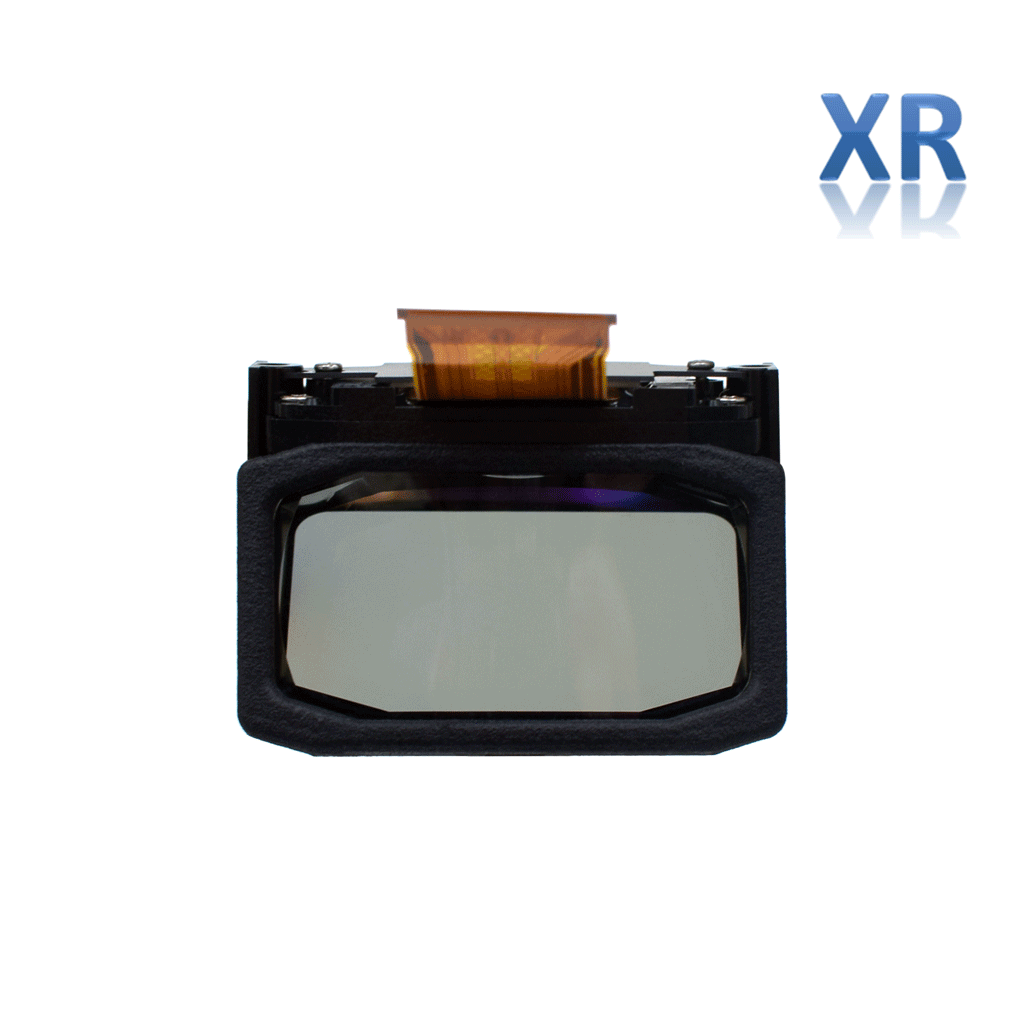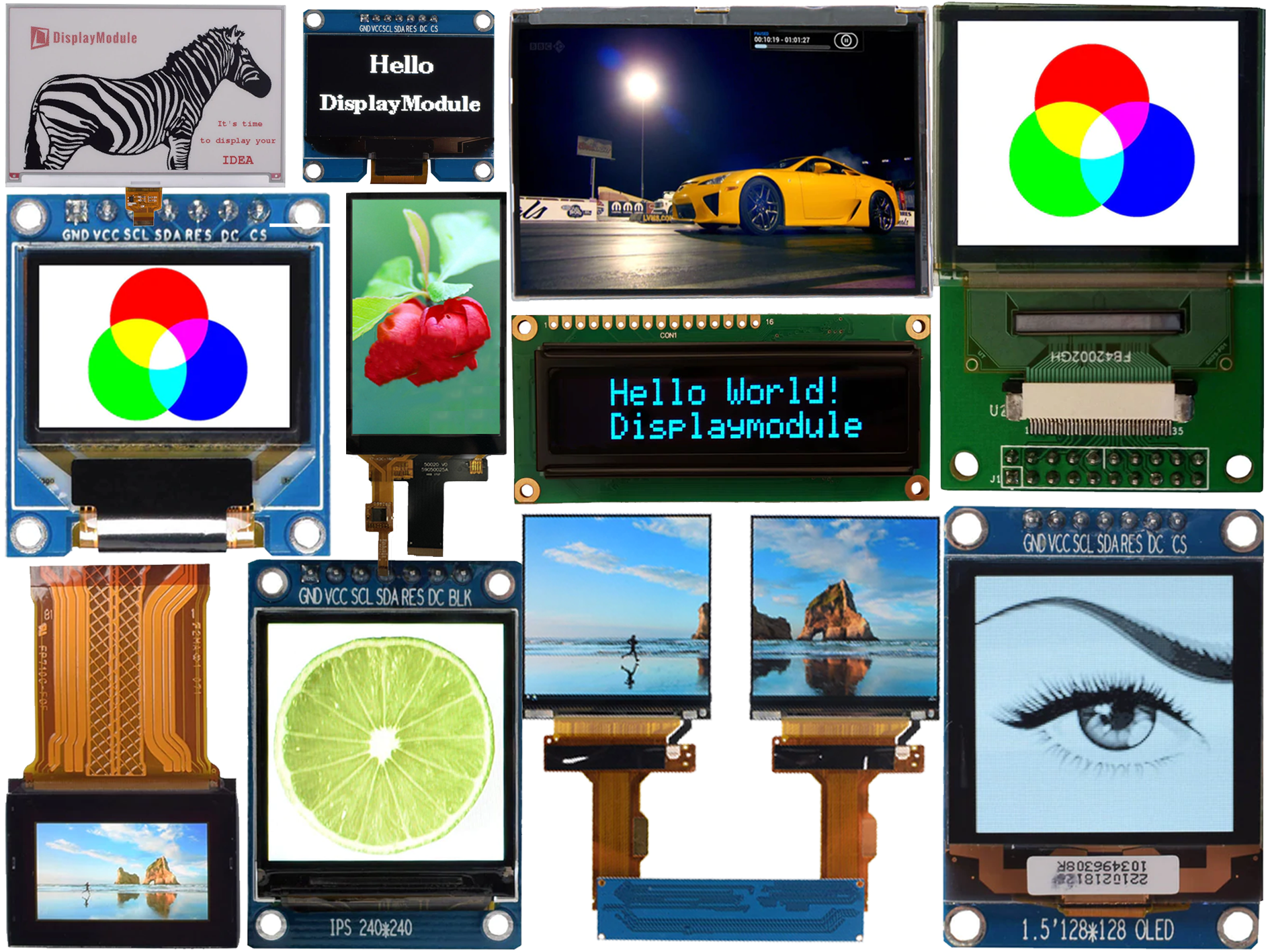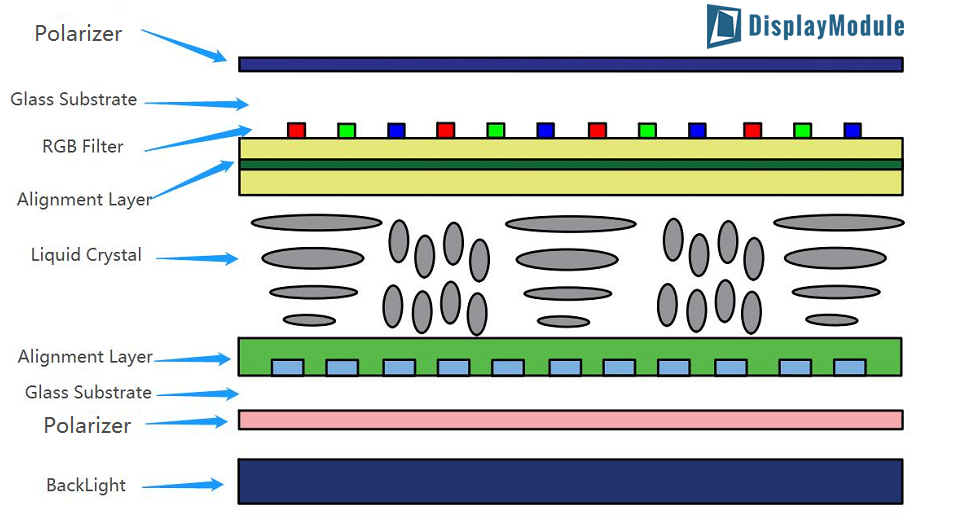The basic principle is to fill the liquid crystal material between two parallel plates, and change the arrangement of the molecules inside the liquid crystal material by voltage, so as to achieve the purpose of shading and transmitting the light of the back-light source to display different shades and scattered patterns. Moreover, as long as a RGB filter layer is added between the two flat plates, a color image can be displayed.
TN
TN (Twisted Nematic) is a commonly used liquid crystal panel.the liquid crystal molecules can be twisted by 90° when voltage is applied or not applied at both ends of the liquid crystal panel. In fact, TN-type LCD screens can be divided into static drive or passive drive.mainly used to display characters and simple images. and another type is use active matrix drive mode ( TFT thin film field effect transistor) driven TN-TFT display, which is what we usually call ordinary TFT liquid crystal display. Generally speaking, the TN-type liquid crystal display refers to the pen-type, character-type and dot-matrix liquid crystal display screens that adopt static driving or passive driving. Most of them are black and white LCD screens.
TN screens consist of multiple layers. An ultra-thin liquid crystal mixture layer twisted 90° is located between two thin glass plates coated with transparent electrodes. The polarizer is on the outside of the glass plate, while the inside houses the color filters, transparent electrodes, and alignment layers for orienting the LC molecules. Used in conjunction with a polarizer, it acts as a "light valve" for the back-light.

STN
STN liquid crystal (Super-twisted nematic display) , After the invention of TN liquid crystal, people naturally think of matrixing TN liquid crystal to display complex graphics. The advantages of TN mode are fast response speed, high transmittance, low cost and high yield. The shortage is that the viewing angle is narrow, and the number of driving channels (or display capacity) is very limited.Compared with TN liquid crystal twisted by 90 degrees, STN liquid crystal twisted by 180 degrees to 270 degrees, which greatly improves the viewing angle and the number of driving channels.
There are many types of STN liquid crystals:
-
FSTN- Film Compensated STN
-
CSTN- Color Super-Twist Nematic
-
DSTN- Dual-scan Super Twisted Nematic
-
DSTN- Double layer Super Twisted Nematic
TFT
TFT (Thin Film Transistor) means that each liquid crystal pixel on the liquid crystal display is driven by a thin film transistor integrated behind it. Thereby, the screen information can be displayed at high speed, high brightness and high contrast ratio. It belongs to a kind of active matrix liquid crystal display.
It is characterized by good brightness, high contrast, strong layering and bright colors, but it also has the disadvantages of relatively power consumption and high cost.
IPS
The IPS screen is a technology based on TFT, and its essence is still a TFT screen. IPS screen (In-Plane Switching) technology is a liquid crystal panel technology launched by Hitachi in 2001, commonly known as "Super TFT"
The advantage of IPS technology is that it changes the arrangement of liquid crystal molecules and adopts lateral conversion technology. That is, the two electrodes are on the same plane. Unlike other liquid crystal mode electrodes, the electrodes are arranged on the upper and lower sides.
Due to the adoption of horizontal conversion technology, the response speed of the LCD screen is faster and more stable. When dealing with continuous dynamic pictures, a major advantage of horizontal conversion is to speed up the deflection of liquid crystal molecules. It is reflected in the advantages of fast response speed of the IPS hard screen, which makes the motion trajectory of the image more delicate and clear, and solves the troublesome problems of image smear and jitter.
OLED
OLED (Organic Light-Emitting Diode) display technology is different from the traditional LCD display method, which does not require a back-light.Uses a very thin coating of organic materials and a glass substrate or flexible organic substrate), and these organic materials emit light when an electric current is passed.
Compared with traditional LCD technology, OLED display technology has obvious advantages. The thickness of OLED screen can be controlled within 1mm, while the thickness of LCD screen is usually about 3mm, and the weight is lighter. The liquid structure of the OLED screen can ensure the anti-aging performance of the screen, and has a wide viewing angle that LCD does not have, which can realize the viewing of the same screen in a large range without distortion of the picture. The response time is one thousandth of that of an LCD screen. In addition, the OLED screen is resistant to low temperature and can display content normally at -40 °C. It has higher luminous efficiency, low energy consumption, and is ecologically friendly. It can be made into a curved screen, which brings different visual impacts to people.
PMOLED
PMOLED (Passive matrix organic light-emitting diode) have cathode strips, organic layers, and anode strips. The anode and cathode strips are perpendicular to each other. The intersection of the cathode and the anode forms the pixel, which is where the light is emitted. An external circuit applies current to selected cathode and anode strips to determine which pixels emit light and which do not. In addition, the brightness of each pixel is proportional to the magnitude of the applied current.
PMOLED are easy to manufacture, but consume more power than other types of OLED, mainly because they require external circuitry. PMOLED are most efficient when used to display text and icons, and are suitable for small screens (2-3 inches diagonal), such as those often found on mobile phones, PDAs, and MP3 players. Even with an external circuit, passive matrix OLED consume less power than the LCD currently used in these devices.
AMOLED
AMOLED (Active-matrix organic light-emitting diode ) has a complete cathode layer, organic molecular layer, and anode layer, but the anode layer covers an array of thin film transistors (TFT), forming a matrix. The TFT array itself is a circuit that determines which pixels emit light, which in turn determines the composition of the image.
AMOLED consumes less power than PMOLED because the TFT array requires less power than external circuits, so AMOLED is suitable for large displays. AMOLED also has a higher refresh rate and is suitable for displaying video. The best uses for AMOLED are computer monitors, large-screen TVs, and electronic signboards or signboards.
Micro OLED
The Micro-OLED uses a single crystal silicon wafer as the back-plane, which has the characteristics of self-luminescence, thin thickness, light weight, large viewing angle, short response time, and high luminous efficiency, and it is easier to achieve high PPI (pixel density) ), small size, easy to carry, low power consumption and other excellent characteristics, especially suitable for near-eye display devices.











Leave a comment
This site is protected by hCaptcha and the hCaptcha Privacy Policy and Terms of Service apply.